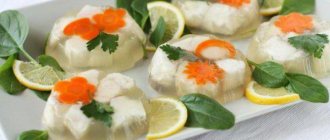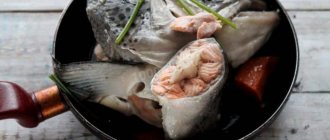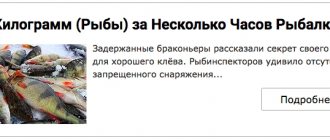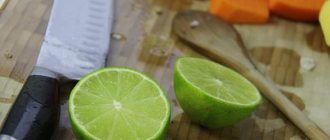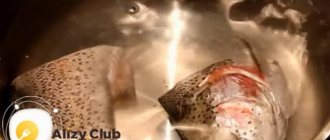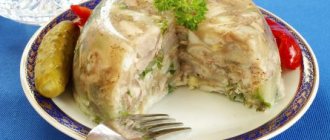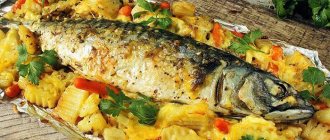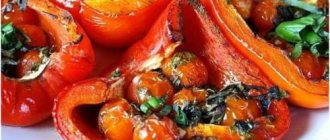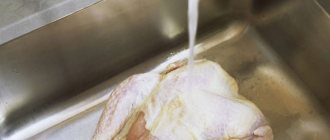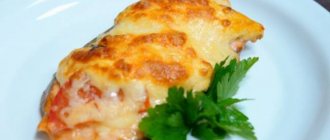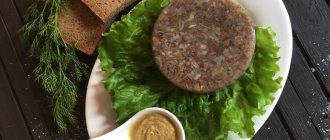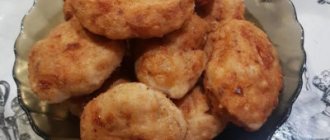Pike perch is a royal fish. It is valued for its tender, tasty meat without fat and a small number of bones that are easy to remove. Many dishes are prepared from pike perch. It is fried and baked, boiled and made into aspic. This is exactly what we will talk about aspic from pike perch. This festive treat will not leave anyone indifferent. So, pike perch aspic with gelatin: holiday recipes.
Jellied pike perch: nutritional value, calories
100 g of raw product – 84 Kcal. The same serving contains 18.5 g of protein, 75.0 g of unsaturated fatty acids. The same serving of jellied pike perch contains 5.13 g of protein, 1.14 g of carbohydrates, 0.33 fat. 100 g of jellied pike perch is 102 Kcal.
Pike perch fillet is very healthy. After all, this noble fish contains many minerals, including calcium, magnesium, potassium, iron, sulfur and others. There are also B vitamins plus nicotinic acid, ascorbic acid, retinol and vitamin E. Pike perch contains up to twenty amino acids, ash, thiamine, and dietary fiber.
Considering the storehouse of valuable substances, we can admit that the meat of this commercial fish from the perch family is necessary for the health of the human body from an early age:
- Helps the functioning of the digestive system;
- Keeps the heart and blood vessels in working order;
- Increases brain activity;
- Increases immunity;
- Removes bad cholesterol;
- Promotes the functioning of the thyroid gland;
- Supports the adrenal glands;
- Helps metabolism;
- Positively affects the organs of vision;
- Gives the body energy;
- Helps lower sugar levels;
- Strengthens nails and affects the appearance of hair and skin;
- Removes toxins from the body;
- Strengthens bone tissue.
Thus, pike perch is a very useful fish. However, it is better for people with diseases of the gastrointestinal tract or obesity to avoid pike perch treats, since this product is high in calories. Also, those who are allergic to seafood should avoid this dish.
Which fish is the healthiest?
Pike perch jellied with gelatin
- Cooking time: 90 minutes
- Number of servings: 6 persons
- Calorie content of the dish: 140 kcal
- Purpose: for lunch, dinner, holiday table
- Cuisine: Russian
- Cooking difficulty: medium
A classic snack recipe for Russian housewives - using gelatin. This simple ingredient makes the process of preparing aspic easier and faster. And its appearance ultimately becomes more presentable. To prepare pike perch aspic with gelatin, you need the following ingredients:
- fresh pike perch – 1 large;
- carrots – 1 medium;
- onion – 1 small head;
- black and allspice - 1 pea each;
- bay leaf;
- salt – approximately 1 tablespoon;
- gelatin – 1 tbsp. l. with a slide;
- water – 1.5 l.
- Remove the scales from the fish, cut off the fins and tail, remove the gills and eyes, cut them open, and remove the entrails.
- Pike perch is a backbone fish - you need to unwrap the fillet and take out the backbone with bones.
- Wash the fillet, cut into two halves, then into pieces.
- Place the backbone, bones, fins in a pan, add onions and carrots, and spices.
- To fill with water. Cook for 40 minutes after boiling, skimming off the foam.
- Strain the resulting broth through a sieve. Place pike perch fillet and salt there. Be sure to return the broth with fish to the heat for another 20 minutes.
- Prepare gelatin: add cool water and leave to swell.
- Remove the fish pieces from the broth and add gelatin. Stir until the gelatin lump is completely dissolved.
- Place vegetable and herb decorations on the bottom of the plates. Pour a little broth, put it in the cold so that the bottom layer sets.
- Then lay out the pieces of fish and pour in the broth. Leave in the refrigerator until serving.
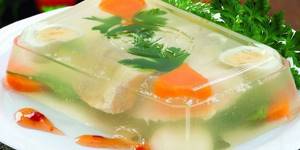
How to make pike perch aspic correctly: chef's advice
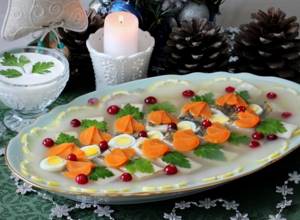
Pike perch aspic will become a decoration for the holiday table if prepared correctly. Experienced chefs say: cooking begins at the store counter. Because taste largely depends on how fresh the ingredients are. So, you first need to make sure that the product is good to begin with.
- Pay attention to the gills. If they are whitish or brown or gray, you cannot buy fish.
- High-quality fish has a pleasant, fresh smell.
- If the fish has cloudy, sunken eyes, you should refuse the purchase.
- A good fish has scales that are spotless and shiny.
- High-quality pike perch feels elastic to the touch.
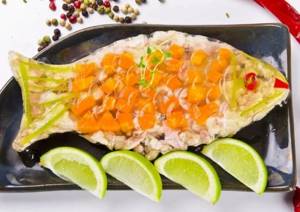
When the fish is selected, purchased and brought home, it needs to be cleaned. Remove the scales and remove the head. The entrails are removed. Slice the fish and rinse with running water. Then the carcass is placed in a container of water and boiled with carrots and onions. To preserve the color of the broth, remove the foam regularly. It is recommended to cook for twenty minutes after boiling. Five to ten minutes before the end of cooking, add salt and spices.
The next step is to remove the pike perch from the broth, leaving the head and tail with fins to cook. The cooking process continues for another twenty minutes. The bones are removed from the fillet. Turn off the broth with the head, fins and tail and strain. Stir gelatin into the prepared liquid.
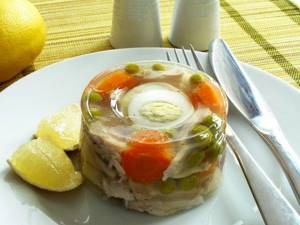
The preparation of the dish begins with pouring a little broth with gelatin onto the dish. Then chopped vegetables, lemon or lime slices and other decorative elements are laid out figuratively and left to harden. Then the fish plastics are beautifully laid out. Fill everything with the remaining broth. Now the aspic should harden well. To do this, the dish is sent to the refrigerator.
Tongue aspic with gelatin
What you need for the aspic: ingredients
In addition to pike perch, carrots are used for aspic - this is a vegetable that is traditionally used for decoration and also adds color and aroma to the broth. Also take onions and bay leaves. The broth needs salt and pepper to taste. In order for the aspic to have the desired shape and not start to melt in the midst of the celebration, you will need gelatin.
If you want to diversify the decor of the dish, you can use lemon, corn, olives, herbs and other products that go well with fish.
How to make light broth
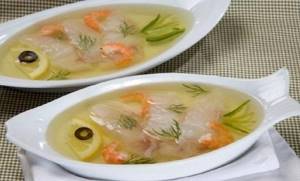
Sometimes housewives complain: they did everything as usual, but the broth is cloudy. This means a mistake was made. How can you make the broth happy with its transparency?
Here are the rules for preserving color:
- Clean the fish well. Remove eyes, fins, gills.
- Rinse the belly, removing the entrails.
- Separate the fillet from the bones.
- Sprinkle the fillets with salt. You can add a little pepper.
- Wrap in parchment. Then hide in foil and fry in the oven at 190 degrees for half an hour.
- Drain the resulting broth.
- Place the pike perch in the parchment in the cold for a couple of hours.
- Grease the head and fins, as well as the tail, with butter and place in a bowl with thick walls.
- Warm over low heat.
- Place the lightly fried pieces of fish in a container in which the broth will be cooked. Pour the water.
- Cook, removing the scum.
- Dip the onion (head), parsley, and peppercorns into the broth.
- Cook for 40 minutes. The lid must not be closed!
- Then let the liquid rest.
- Strain through cheesecloth or cloth, this way all unnecessary fat will remain on the cloth.
- Salt the broth.
This broth is very clear and tasty.
How to cook delicious fish soup
How to calculate the amount of gelatin
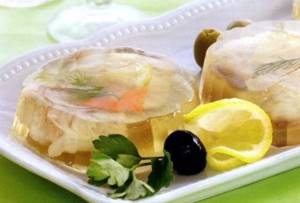
With the help of gelatin, the aspic gains strength, which prevents it from melting at the most inopportune moment.
Of course, the taste of the dish and its shape depend on the amount of gelatin added. You just need to take the right proportions.
So, to prepare aspic, you will need 30 g - a couple of full tablespoons - of gelatin per liter of broth. If you want to create a dish with a dense consistency, then the amount of gelatin needs to be increased. For example, a liter of broth already contains 50 g of thickener. Thus, if two liters of broth are used for aspic, then 100 g of gelatin will be needed.
Step-by-step recipe for jellied pike perch without gelatin
For 1 kg of pike perch take:
- Carrots - 1 pc.
- Onion - 1 pc.
- Water - 3 liters
- Salt - to taste
- Bay leaf
- Boiled eggs, hard-boiled - 2-3 pcs.
You will also need:
- Parsley and celery roots.
- Parsley, dill.
- 2-3 buds of cloves and black pepper - optional.
- Raw egg white to lighten the broth.
How to cook pike perch aspic (step by step)
- The fish's scales and entrails are removed. Heads, fins, and tails are cut off. Rinse. The spine is divided into two halves and all bones are removed. Cut into small pieces. The fillets are set aside for a while.
- Pour cold water over all bony parts, add onions and carrots, and let them cook for at least an hour. The liquid should reduce by almost half.
- The carrots are pulled out, cooled and cut into rings, stars and other shapes. The broth is filtered and put back on the fire.
- Parsley and celery roots are chopped and fried in a dry frying pan, placed in the broth along with fish fillet pieces.
- Cook the pike perch for 15-20 minutes over low heat, avoiding boiling. At the end of cooking, add salt, laurel, pepper, and cloves.
- Strain the broth. If necessary, clarify with protein, let stand for a while, and filter again.
- Place the fillet with pieces of vegetables on a dish. After cooling, decorate with herbs, slices of eggs, lemon slices and pour in chilled broth.
Note: if lemon is used together with roots when storing, do not pour hot broth over hot fish. The result will be an unpleasantly sour taste. If there is no time to wait for it to cool, lemon is added only to the finished dish, garnished with slices when serving.
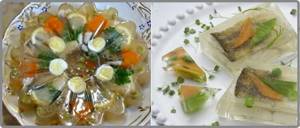
How to make pike perch aspic: options
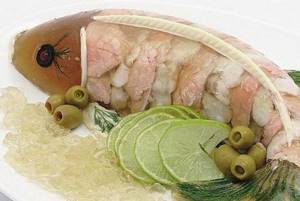
Jellied is always a beautifully decorated dish. There is room for the chef's imagination to run wild here! You just need to consider the color combination. For example, slices of orange carrots and delicate yellow suns of lemon will look good in aspic.
An interesting option is to combine pieces of fish with shrimp, and let there be lime and game between them. Gherkins and bell peppers, green onions, capers, olives, canned corn, cucumbers, etc. are used for culinary decoration.
The compositions can be completely different. And the “peacock tail”, when slices of olives are placed on top of pieces of fish, and the “mosaic”, where multi-colored fragments of vegetables with pieces of fish are frozen in the broth, and the “chamomile field”, when the white of a boiled egg is cut into thin “petals”, and the yolk becomes the middle of the flower. It looks beautiful and gentle.
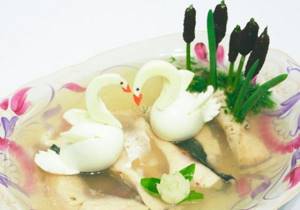
The design is interesting in the form of a pond with swans. In this case, decorative elements are applied after the filler has hardened. Here you will need garlic arrows, onto which crumbs of dough rolled in coffee are attached. These will be reeds. Water lilies are made from onions. The head needs to be divided and each half carefully cut through, creating petals. Place pieces of bright carrots in the center of the water lilies; they should be thin. These will be the stamens.
The swans themselves are made from boiled eggs. On one side of the egg you need to remove a little so that the “belly” stays on the “surface of the pond”. The cut off part of the protein will be used for the tail and wings. The tail and wings are inserted into cuts on the body of the future swan. The neck and head are cut out of the protein. The parts are pinned with toothpicks. A tiny piece of carrot is a beak, the eyes are made from peppercorns.
On one side of the “pond”—the flood pond—a dill meadow appears. Reeds are planted next to the “water”, then – closer to the center – water lilies. The swans are setting up. Parsley or basil leaves will complement the picture. They need to be placed near the water lilies.
Step-by-step recipe for making pike perch jellied

Wash the fish, but do not gut it. Remove scales and gills. The scales on the tummy of the pike perch are small, almost invisible, but they also need to be removed, since they will flake off during cooking. Gut the pike perch, wash the abdomen from mucus and blood. Cut off the fins, tail, cut off the head - put it all in a pan
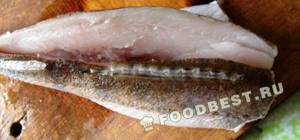
Using a sharp knife, separate the fillet from the vertebral bone of the fish. Place the vertebral bone towards the head and fins
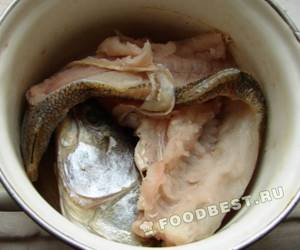
Add spices, peeled carrots and onions to the pan. Later we will add broth here after boiling the pike perch fillet.
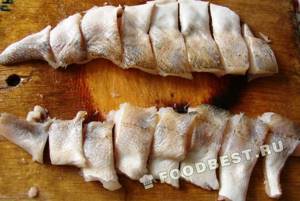
Cut the pike perch fillet into thick slices, place in a small saucepan and add salt.
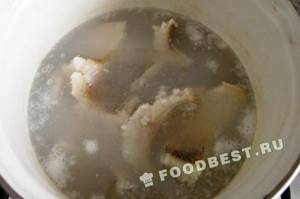
You need to cook the fish pieces for no more than 15 minutes, so after adding water you should not leave the stove. The pieces should not be overcooked.
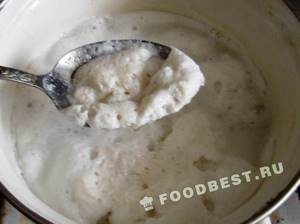
When water boils, foam immediately appears in the pan, which must be removed carefully. The remaining foam in the broth will make it cloudy.
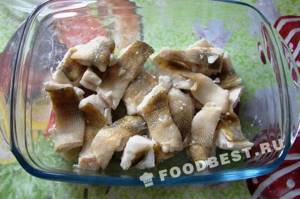
Carefully remove the fish pieces from the broth and do not disassemble them until the fish has cooled down. At this time, you can use a fork to remove the bones from the fillet pieces, although you usually don’t have to do this.
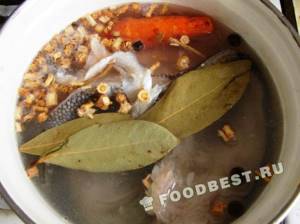
Pour the broth over the remaining fish that we separated during gutting. Cook until the carrots are ready.
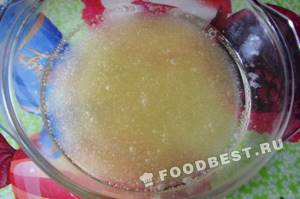
Pour the gelatin into a cup, add a small amount of water, and wait until it swells completely.
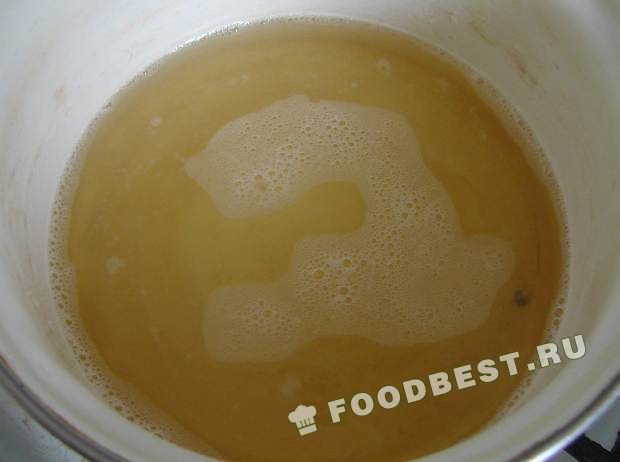
Drain the broth, strain through cheesecloth, and cool. Add the swollen gelatin, mix, heat until the gelatin is completely dissolved. Then cool until warm.
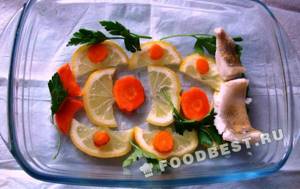
Place thin slices of lemon, slices of boiled carrots and sprigs of parsley on the bottom of the container. If the dish will be served in the same container, then place the fish pieces with their backs up. If the dish is intended for serving in portions, then add pieces of fish randomly.
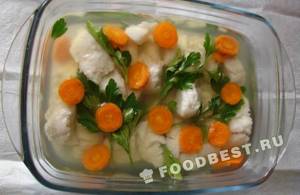
Pour the contents of the container with warm broth, put the jellied fish in the cold until the gelatin-broth filling completely hardens.
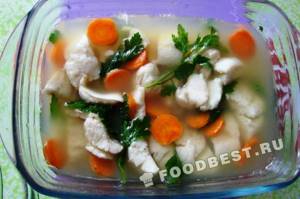
The jellied pike perch is ready.
It is customary to serve the dish with grated horseradish and strong drinks. Category – Jellied dishes
Recipes
It is already known that it is gelatin that makes the dish elastic and does not allow it to melt. Many delicious and interesting dishes are prepared using this thickener. Jellied is no exception.
Step by step recipe
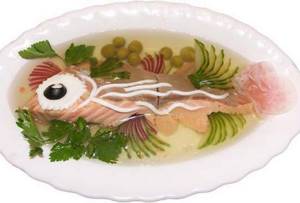
What you need to take for cooking:
Pike perch, onion, half a lemon or lime, one carrot, a couple of tablespoons of salt (tablespoons), spices (peppercorns), bay leaf, 15 g. package of gelatin.
How to cook:
- Prepare the fish, wash and cut.
- Prepare vegetables: peel.
- Pour water all together and cook.
- Also add the fins, tail and head to the pan.
- Add salt.
- Cook for a quarter of an hour, periodically removing the scum.
- Remove the fish.
- Remove the bones.
- Boil the broth until done. This can be determined by piercing a carrot with a fork.
- Turn off the broth, remove the vegetables.
- Prepare gelatin by diluting with water. A little water is needed for the gelatin to swell after 30 minutes. If the gelatin is instant, there is no need to soak it.
- Strain the broth.
- Add gelatin to the broth. Mix.
- Pour some of the broth onto a dish and arrange the pieces of fish.
- Arrange the chopped vegetables and lemon.
- Pour the rest of the broth on top.
- Let it harden.
Lightly salted fish at home
Jellied pike perch from Yulia Vysotskaya
What to take:
Medium-sized pike perch fillet, ten boiled quail eggs, carrots and onions, lemon, a quarter cup of canned peas, spices, salt, herbs, two plates of gelatin, bay leaf (to taste).
How to cook:
Clean and wash the fish. Slice. Place the pieces in a container with vegetables and spices and cook in water, removing the scale. After a quarter of an hour, turn off. Dilute gelatin using 200 g of broth. Then pour this liquid into the remaining broth.
Divide the quail eggs into two parts. Cut the lemon into slices. Cut the carrots into shapes.
Place pieces of fish on a dish, between vegetables and peas, garnish with parsley. Pour in the broth, being careful not to damage the decor. Refrigerate to set.
Without gelatin
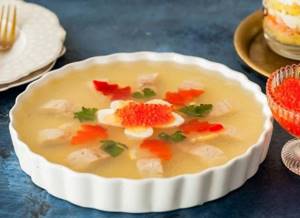
Some housewives do not like adding gelatin to food, believing that the thickener steals some of the aroma and taste. Well, you can do without gelatin.
What you will need for preparation:
Pike perch and sea bass - one fish each, celery, parsley root, onion, 800 ml of water, salt, bay leaf and spices (to taste), lemon, olives.
How to cook:
Attention: if you prepare aspic without gelatin, you need to buy only fresh fish! Prepare the fish by cleaning the outside and inside. Cut the fillet. Place the rest in water and cook for two hours over very low heat. The scale needs to be removed. During cooking, add vegetables and spices. Place the fillet that has been cut out in a separate bowl and cook it too. Then the fillet is cut and placed on a plate. Chopped vegetables for decoration, as well as herbs, are laid out on the same dish. You can add sprigs of greenery. All this is poured with rich broth. This aspic should stand in the cold for 24 hours to harden well.

By the way, you can cook the broth not on the stove, but in a slow cooker. To do this, select the “Steam” mode. Then you need to remove the fish from the bowl, remove the bones, and then turn on the multicooker again for 15 minutes. The broth is also strong and can freeze well.
Herring under a fur coat classic recipe step by step
Pike perch aspic can be prepared with or without gelatin. In any case, there must be a high-quality broth, transparent, beautiful, so that the aspic looks appetizing. You can use a variety of vegetables for decoration, and the pieces of fish can be both large and small. It all depends on the taste and desire of the cook. If the aspic is prepared according to the rules, if all the culinary wisdom is followed, then the dish will be worthy of kings.
Health to you and your loved ones! Natalya Belokopytova.
Jellied pike perch
It just so happens that the New Year is not the New Year at all without the “Irony of Fate”, Olivier salad, jellied meat and jellied fish, which I suggest you prepare on the eve of the holiday.
COOKING
Gut the pike perch, remove the scales, cut off the fins and fillet it. First cut off the head and tail, then cut the ribs where they attach to the spine.
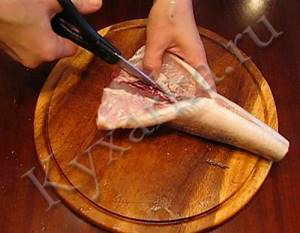
Moving all the time along the ridge, carefully separate it from the pulp, cut off and remove.
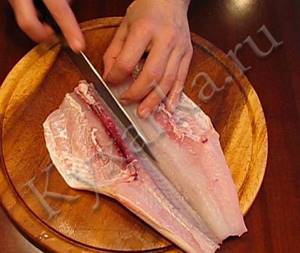
Cut off the rib bones.
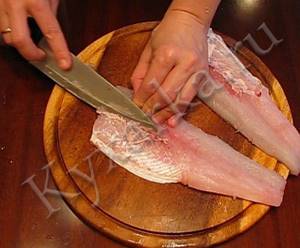
Salt the fish fillet and wrap it in foil (skin side down).
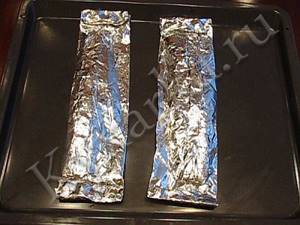
Place in an oven preheated to 100°C for 1 hour so that the fish cooks in its own juices. Remove the envelopes with fish from the oven, let them cool completely and only then carefully unwrap them.
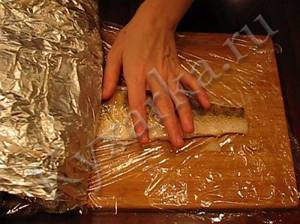
Drain the resulting juice, and carefully transfer the fish to cling film, wrap it and put it in the refrigerator for 2-3 hours, or better yet overnight, so that it thickens and does not crumble when slicing.
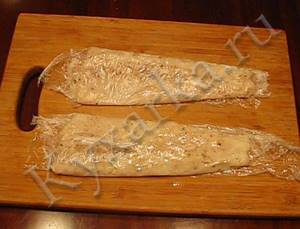
Fill fish bones and heads with cold water 3–4 cm above the fish.
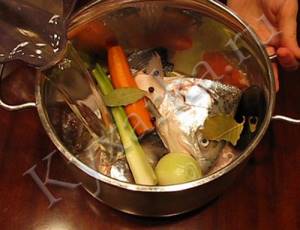
Add the celery stalk, onion, and carrots and place over medium heat. Before boiling, skim off the foam, add pepper, bay leaf and lightly salt.
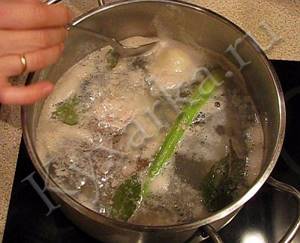
Cook uncovered at medium heat for 15 minutes. Add white wine, bring to a boil and cook for another 15 minutes.
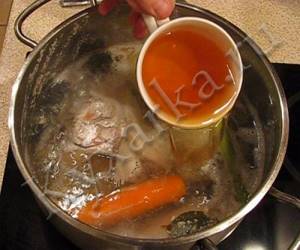
Get the fish. I used it to prepare mini aspics in molds. You can see how it all happened here.
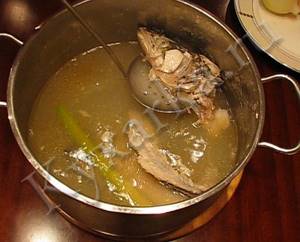
Strain the broth through a sieve lined with 4 layers of gauze.
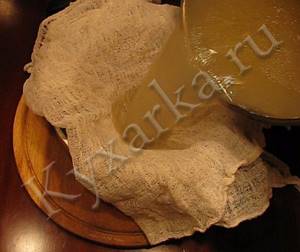
If there is a lot of broth (for aspic you need 1 liter) and it is not strong enough, you can boil it with the lid open and intense boiling. After boiling, add salt to the broth, let it cool, and then put it in the refrigerator for 2-3 hours, or preferably overnight, so that large particles that cause turbidity settle. Drain off the sediment. Soak the gelatin in a small amount of broth for the time specified in the instructions, and then gently heat until dissolved. The amount of gelatin is determined by the volume of the broth.
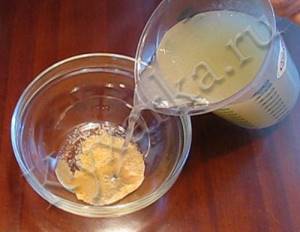
Add the gelatin solution to the broth, stir and check for clarity. If the broth is cloudy, beat the egg white into a strong foam and gently stir into the broth.
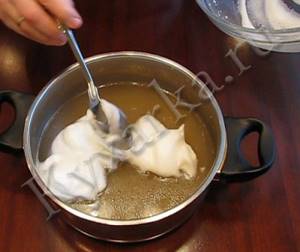
Add crushed eggshells here. Place over medium heat and bring to a boil while stirring constantly. As soon as the protein rises, remove the pan from the heat and set aside for 10 minutes.
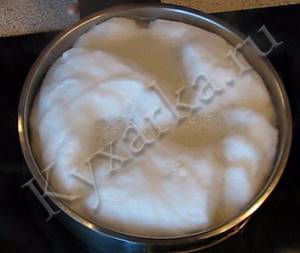
Repeat the procedure twice more. Then strain the broth several times through a sieve lined with gauze and cool to room temperature.
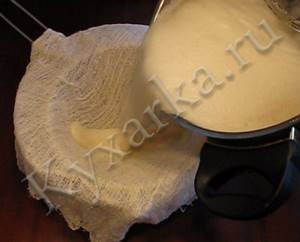
Pour a small layer of broth into the bottom of the aspic dish and put it in the refrigerator until completely set. Place the chopped fish on a layer of frozen jelly, lightly pour over the broth and put in the refrigerator until the fish hardens and sets.
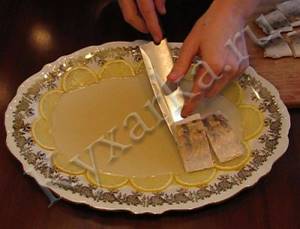
Lay out the decor, carefully pour the broth over it and let it harden so that the decorations are fixed.
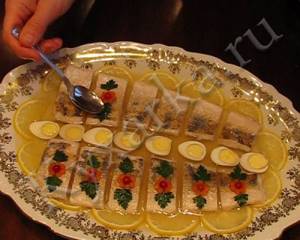
Pour the broth over the fish until it is covered in a thin layer.
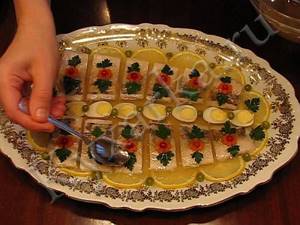
Let it set and enjoy your meal!
